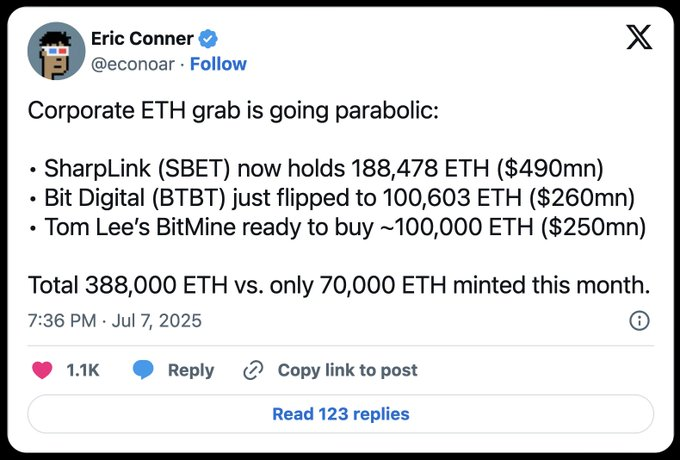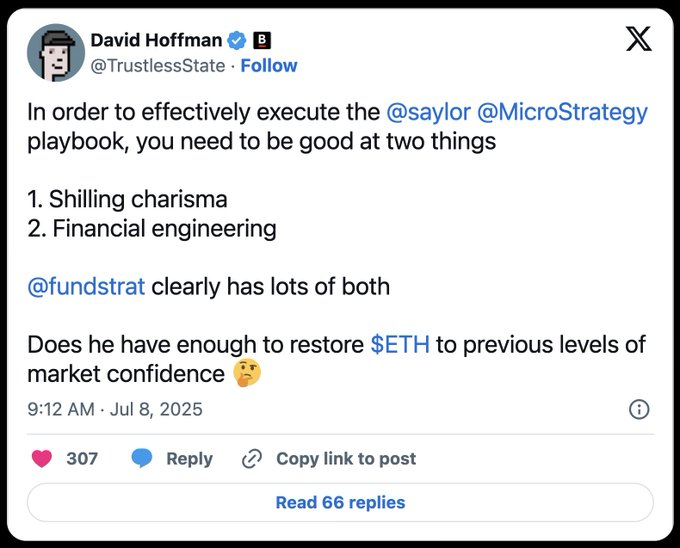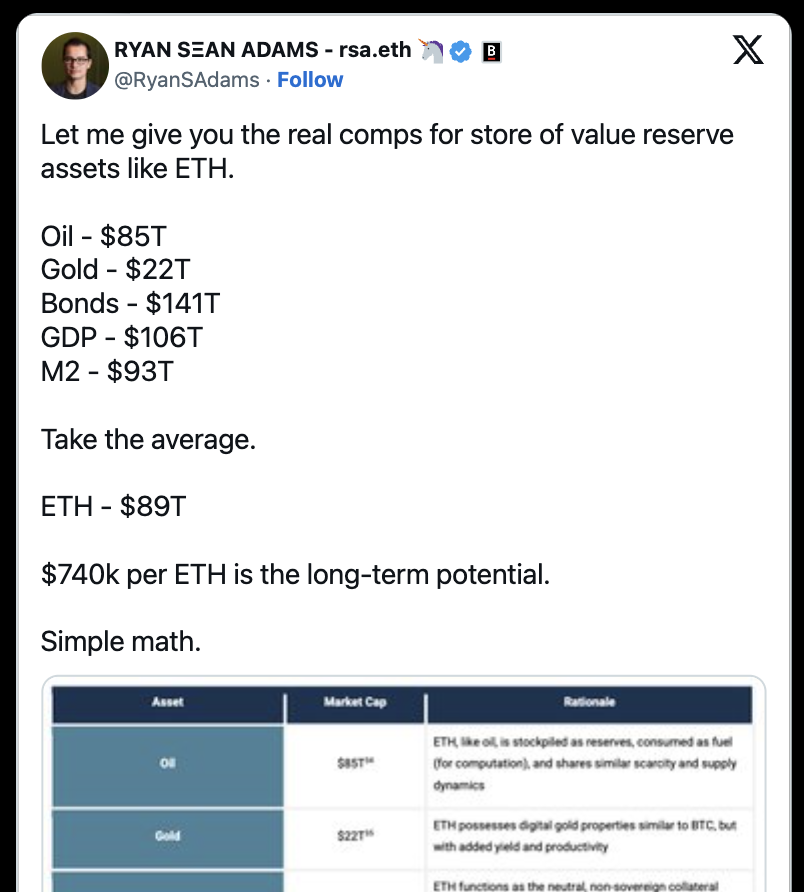Original author: David Hoffman
Original translation: TechFlow
Ethereum is winning, ETH investors are still not winning
You may have noticed that I have become more dovish on ETH recently. ETH’s decline in relative valuation has led to a loss of investor confidence, which is key when ETH aspires to become the internet’s currency.
The reasons for ETH’s underperformance have been a point of debate for years. Many of the issues plaguing ETH’s relative valuation are beyond its control — Gary Gensler, Michael Saylor, and others have contributed to this. (Gensler has left, and ETH Fund Management has finally been established; some external issues will resolve themselves.)
Today, I want to focus on the challenges that are firmly in the hands of the Ethereum community, as many of the reasons why Ethereum has lagged behind the market for more than three years have been determined by the community itself. We should focus on solving these issues to revitalize potential ETH buyers.
ETH’s value capture problem
Many of the challenges Ethereum faces can be summarized into one core theme: there is a broken value capture supply chain between Ethereum’s utility and ETH’s value.
“I’m surprised that…stablecoin usage on Ethereum, Solana, Tron…doesn’t seem to create more value for the Layer 1 token holders that these stablecoins rely on.”
— Joe Weisenthal on The Chopping Block

In this episode, the CB team continues to discuss this Ethereum-specific problem as SOL and TRX have hit all-time highs and Ethereums economic model is particularly flawed compared to its competitors, especially the Layer 2 model.
Speaking of stablecoins, as early as the bear market of 2018-2019, people have raised concerns about the relationship between stablecoin supply and the value capture of its Layer 1 tokens. Nic Carter published an article on Bankless in 2020 to discuss this issue - Crypto-fiat currency: mutualism or parasitism?
In short, stablecoin buyers and holders on Ethereum Layer 1 do not add any value to ETH except for spending about $0.50 in gas fees to buy these stablecoins. If they do the same on Layer 2, even if billions of dollars worth of stablecoins are purchased, ETHs value capture will drop to less than $0.01.
Ethereum’s narrative momentum
Nonetheless, Ethereum’s adoption metrics are undeniably bullish.
The recent launch of Robinhood Chain, which deploys tokenized stocks on Ethereum, validates Ethereum’s Layer 2 roadmap and its position as a trusted neutral settlement layer for Wall Street assets. With Robinhood Chain, OG’s promise that blockchain technology would upgrade Wall Street’s outdated financial system to enable tokenization and trading is coming true.
This announcement is just one of many bullish signals for the network:
The Ethereum ecosystem maintains a dominant 50% of the stablecoin supply, and if you ignore the opaque Tron ecosystem, its share is as high as 75%.
CRCL’s blockbuster IPO was particularly validating for Ethereum, as Ethereum holds 66% of all USDC.
Coinbase, the most trusted and respected brand in the crypto industry, is building Ethereum Layer 2.
Ethereum has 100% uptime, prioritizes true decentralization, and does not require any counterparties to resonate with Wall Street and enhance its brand image against other competitors.
The economic influence of ETH Funding Corporation is growing:
Original tweet link: click here

If you want to make a bullish case for ETH and Ethereum, it’s getting easier and easier to do so.
All the hard work that Ethereum developers have put in to maintain decentralization and credible neutrality has paid off, with incredible adoption metrics in the world’s capital gravity center: Wall Street.
Expanding the ETH narrative
Many people look at the adoption and success stories above and see opportunity.
Tom Lees Bitmine fund management strategy is taking advantage of Ethereums narrative advantage. The strategy is simple: put ETH on the balance sheet and then sell ETH to Wall Street. Ethereum itself has many narrative highlights. All ETH needs is someone who is dynamic enough to excite Wall Street.

We are about to witness just how undervalued ETH has been over the past four years. Is ETH’s poor price performance a result of market irrationality? Or does its decline truly reflect deeper, more structural issues?
Tribalism and social scalability
Digging deeper into the above, you will gain a deeper understanding of both aspects of ETH.
On the one hand, a network that adopts a Layer 2 model cuts off a link in the ETH value capture supply chain. But on the other hand, you have an incredible success story that seems like Wall Street only needs a slight push to get ETH to $10,000.
Here’s how I think about this dichotomy:
If you add narrative firepower to an unresolved value capture supply chain, you get tribalism that is loved by tribal insiders and rejected by tribal outsiders:
Original tweet link: click here

Now, most people in Ethereum would be excited to see Ryans proposed price of $740k per ETH, while people outside of Ethereum would probably see the same thing and think its delusional (just read QT).
But let’s imagine an alternative scenario where ETH’s superior value capture supply chain becomes a core part of the ETH narrative, as it is in 2021. In this scenario, all Ethereum Layer 2 is based on Native + Based Rollup, and Ethereum’s block time is reduced to about 2 seconds (which is Ethereum’s long-term goal).
In this world:
Rollup is synchronously composable, so no network bridge is required. Lower Layer 1 block times allow market makers to offer lower spreads, resulting in greater on-chain trading volume. Price execution is significantly improved.
Ethereum’s robust MEV infrastructure can eventually be used to provide traders with best execution (on Memecoin etc) rather than the ~20% wool they find elsewhere.
Cross-chain liquidity flows back to Layer 1, and Native+Based Rollup can seamlessly access Layer 1 liquidity, and transaction volume increases accordingly.
Based+Native Rollup consumes 10 to 100 times more gas than the current L2 while providing shared liquidity and composability, which means that all these activities on Rollup actually consume a lot of ETH.
Tokenized assets on Rollups are accessible to the rest of the Ethereum ecosystem. Ethereum’s position as a tokenized asset issuance and trading platform will be further enhanced.
What I’ve laid out above is a future where the feedback loop between Ethereum’s utility and ETH value capture is restored.
Original tweet link: click here
Breaking down the tribalist narrative
In 2024, Bitcoin went from being an asset promoted primarily by its tribal community to being considered a “special snowflake” by the world’s most powerful governments. Only Bitcoin has a strategic reserve. No other asset has this reserve.
Bitcoin’s fundamentals (21 million cap) force non-tribal investors to own at least some Bitcoin.
Ethereum needs to do the same thing.
While Tom Lee and all the other ETH money firms are preaching the gospel of ETH to Wall Street, it would be much better if they could stand on a coherent value capture story and use that as leverage.
The Ethereum community must quickly fix the feedback loop between Ethereum utility and ETH value. We understand the necessary inputs. We also understand the stakeholders, including many who are already involved in achieving this vision, and some who may need to be convinced by the rest of the community. We believe we can get there.
What’s at stake? A more effective Ethereum growth story that we can sell to the world — one that will finally achieve what the ETH tribe wants ETH to achieve: break the $10,000 price mark.










